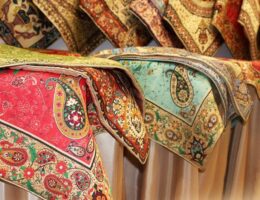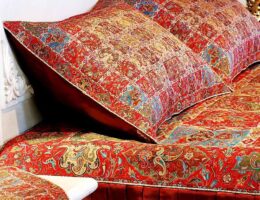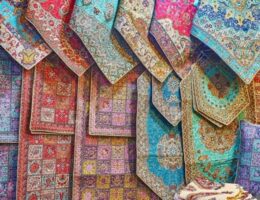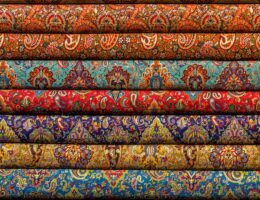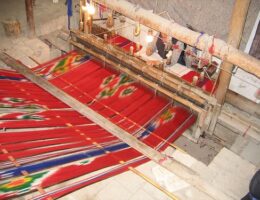IRAN ART EXHIBITION: TERMEH IS DESIGNED WITH TRADITIONAL IRANIAN PATTERNS
Termeh is a handwoven textile that includes a delicate fiber. It is made of wool or silk or coat with traditional Iranian patterns. Termeh is woven with curved patterns such as paisley and Goljam in different colors. Goljam is known as Shah abbasi flower is a popular pattern used in Termeh weaving. Termeh had different use in the past such as weaving cloths for aristocratic families, curtain, and as a gift in the wedding ceremonies.
• History
This precious textile dates back to the Safavid era. Some believe that the first start of Termeh weaving began in Iran, even though some believe that it belongs to the heart of Central Asia and Kashmir. This art reached its peak of development during the reign of Shah Abbas and became one of the export products of Iran.
• Steps of weaving
Different steps of Termeh weaving are as follows:
The first step is preparation of raw materials. The second step includes washing the wool, then spread them under sunlight to become white. After the fibers became white enough, it’s time to dye them. The color of Iranian Termeh is usually made of natural herbs. The standard colors using in Termeh weaving are sangria, red, green, orange, and black.
• Maintenance and Washing
IRAN ART EXHIBITION: Termeh is woven with various designs in different parts of Iran; one of the best samples of it belongs to Yazd. Due to its high density in warp and weft, this kind of textile has good hardness. You need to protect it from sunlight, humidity, and webbing clothes mot. Naphthalene is the best organic compound to protect it cloths against webbing clothes mot. Remember, to washing Termeh take it to the dry cleaning.
• Where can you buy the best kind of Termeh?
You can find the best kind of Termeh in Yazd, Kashan, Kerman, and Tehran city, but you will see the best samples of it in Yazd. If you decide to travel to Yazd or Tehran, you need to know about the best time for journey.

Yazd:
The best time to visit Yazd is from early March to early April .You can buy the best kind of Termeh in Jame Mosque (Masjed Jame) Street, Yazd, Yazd Province. To reach there, you can call number 1828 or 1838 to request a car. Moreover, you can install the Snapp application on your mobile and take a car.
Tehran:
You can visit Tehran during all season. You can buy the best kind of Termeh in Bazaar of Tajrish and Grand Bazaar. The main entrance to the Tajrish Bazaar is on the southwest side of Tajrish Square, next to Tajrish bus rapid transit station. You can use metro, get on the metro train in line-1 and get off at the Tajrish metro station. Moreover, you can install the Snapp application on your mobile and take a car.
IRAN ART EXHIBITION: Termeh is a woven fine and precious cloth with traditional Iranian patterns or textures which is woven by hand with two sets of warp and weft yarn made of pile, wool, natural and synthetic high-quality silk with tall fibers.
Although some believe that the origin of Termeh is the heart of Central Asia and Kashmir highlands, some other believe that weaving Termeh has originated in Iran and then found its way to Kashmir. However, weaving Termeh was developed and became popular in the early Safavid period in Isfahan, and its excelling evolution took place in the reign of Shah Abbas Safavid and became one of the Iranian exportable products.
Taste and initiative of Iranians in the weaving delicacy, material and fantastic schemes of this handicraft is unique; therefore, one of the important duties and barriers of the weaver of Termeh is on choosing and matching the colors as this matching is done whether by choosing harmonious colors or even by choosing contrasting colors in a particular form which can represent kind of congruity and beauty and it is considered as a secret in the Iranian style of weaving Termeh.
In general, the colors for weaving Termeh, and especially colors used for its texts, consist of natural herbal colors as well as natural materials in colors like dark red, light red, green, orange, and black; and, the patterns generally include various traditional curved patterns and schemes.
This delicate and fine cloth had been used for different occasions such as sewing aristocratic and noble clothes, curtains, prayer rugs and robe, and were worn mainly by people from noble, aristocratic and monarchal classes, in the past times; however, in the present time, most of the upper- and middle-class people offer it to each other as gifts in weddings, eves, and official or family occasions, and is sometimes used as furniture cloth or table cloth.
Nowadays, Termeh craft which is on the edge of extinction is only woven in the Yazd Province and sold in the other provinces.

